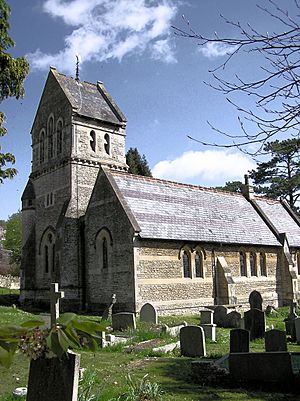St Michael's Church, Monkton Combe facts for kids
Quick facts for kids St Michael's Church, Monkton Combe |
|
|---|---|
 |
|
| 51°21′22″N 2°19′43″W / 51.35611°N 2.32861°W | |
| Denomination | Church of England |
| Churchmanship | Broad Church |
| History | |
| Dedication | St. Michael |
| Administration | |
| Parish | Monkton Combe |
| Diocese | Bath and Wells |
| Province | Canterbury |
St Michael's Church is a special church in Monkton Combe, a village in Somerset, England. It belongs to the Church of England. For a while, it was also the main church for the nearby area of Combe Down. This changed in the 1850s when the two communities became separate. Today, St Michael's Church is recognized as a Grade II listed building, which means it's an important historical building that needs to be protected.
Contents
About the Church Building
The church building you see today was mostly built in the middle of the Victorian era. This was a time when Queen Victoria ruled Britain (from 1837 to 1901). The church is designed in a style called Early English Gothic Revival. This means it looks like churches from the early Gothic period, but it was built much later.
The church has a very steep roof made of different colored Welsh Slate tiles. This colorful roof and other features make it easy to tell that it was built in the mid-1800s. On top of the main tower, there is a shiny, golden weather cock. This is a weather vane shaped like a rooster that shows which way the wind is blowing.
The First Church: Norman Times
The village of Monkton Combe got its name because it was once owned by the monks of Bath Abbey. "Monkton" means "monks' town." The very first church building on this spot was thought to be an "ancient Norman" church. This means it was built a very long time ago, during the Norman period in England (after 1066).
Records from 1757 describe this small, old church. It was about 50 feet long and 16 feet wide. It had a part called a chancel and at least two rows of benches for people to sit on. The records say, "The church is a small structure... at the west end in a little stone turret hangs two small bells. It is dedicated to St. Michael."
A New Church in the 1800s
Around the early 1800s, the old Norman church needed a lot of repairs. Instead of fixing it, the people decided to pull it down. They used some of the old materials to build a new church. This new church was about the same size as the old one and could seat only 95 people. It was built in 1814.
However, this church didn't last very long either. In 1863, a new vicar named Reverend Francis Pocock came to Monkton Combe. He found the church in bad condition and too small for the growing community. Reverend Pocock was brave and decided to completely rebuild the church. He also went on to start Monkton Combe School in 1868.
The Church Bells
The church tower holds a set of eight bells that can be played together to make music. This set of bells was put in as a special way to remember Reverend Francis Pocock. He was the vicar of the church from 1863 to 1875.
The bells were made by a company called J. Taylor in Loughborough. They were officially dedicated at Easter in 1927 by the Lord Bishop of Bath and Wells. There are also two smaller, very old bells in the tower. These bells are survivors from one of the earlier church buildings on this site.
The Organ
Inside the church, there is a large musical instrument called a pipe organ. This organ has two keyboards, called manuals. It was made by a company named Henry Jones and Sons.
The Churchyard
The land around the church, called the churchyard, is a burial ground. It is the resting place of Harry Patch. He was known as the "Last Fighting Tommy" because he was the last surviving British Army soldier who fought in World War I. Harry Patch lived to be 111 years old. He was buried in the churchyard in July 2009, close to the graves of several members of his family.
Past Vicars of St Michael's
Many different vicars have served at St Michael's Church over the years. Here are some of them:
| Name | Years as Minister |
|---|---|
| The Revd F. Pocock | 1863–1876 |
| The Revd A.G. Gristock | 1876–1882 |
| The Revd D.L. Pitcairn | 1883–1914 |
| The Revd Sir M.H.P. Beauchamp | 1914–1918 |
| The Revd P.E. Warrington | 1918–1961 |
See also
- List of ecclesiastical parishes in the Diocese of Bath and Wells

